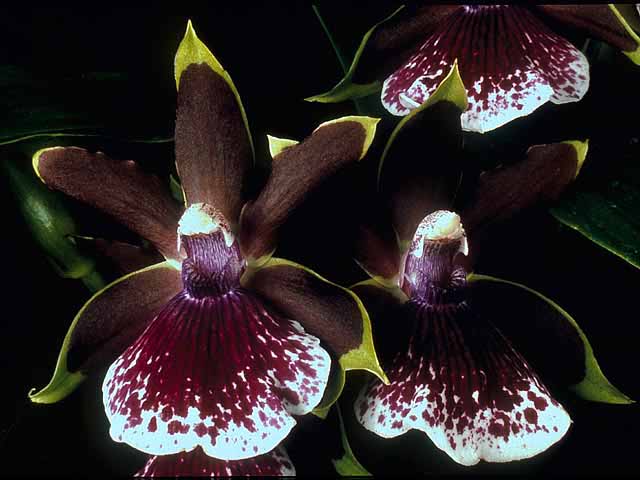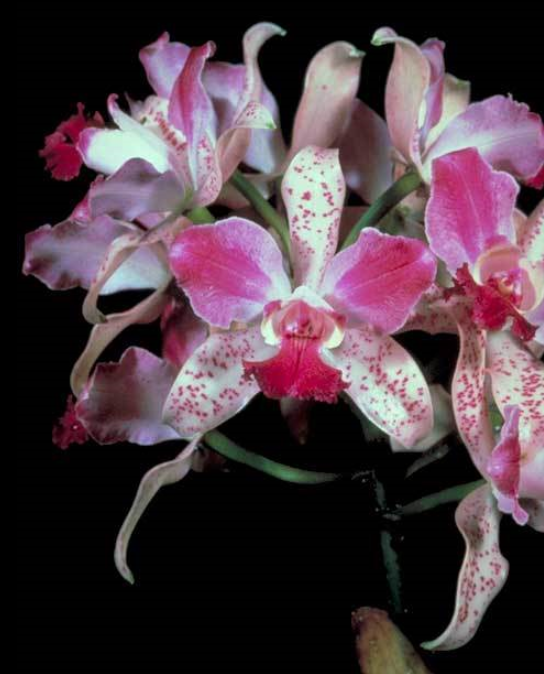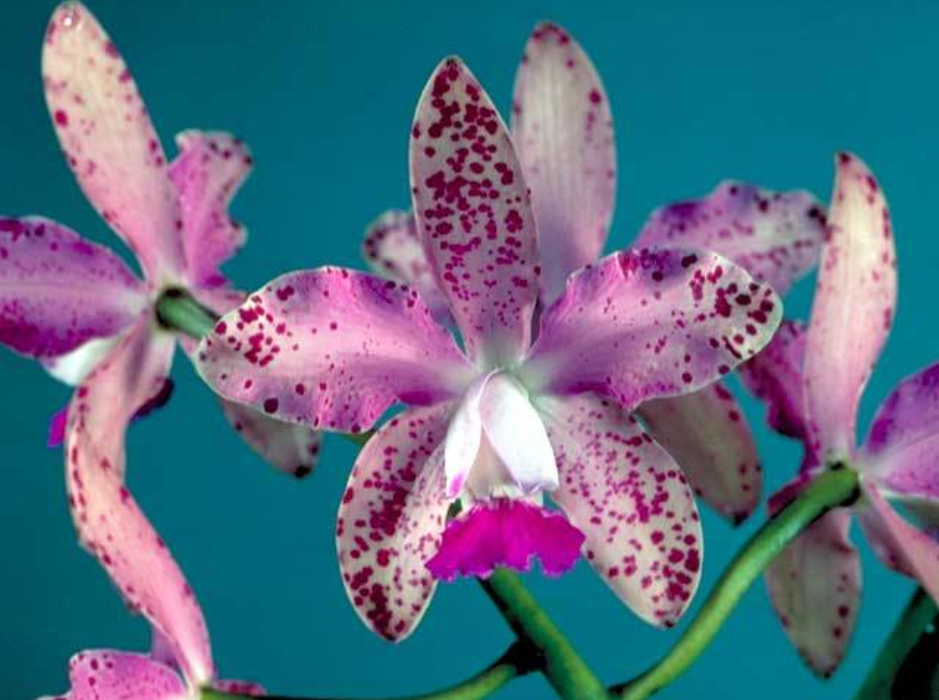
© 2004 Loren Batchman
Zygolum Louisendorf 'Solana Beach' HCC/AOS — you can call it Zygolum Louisendorf grex 'Solana Beach', both are equally correct — exhibited by Loren Batchman, August 23, 2004, at the Long Beach judging center.
February, 2021

Can We Possibly Make Orchid Labels Any More Complicated?
How many of you already struggle to fit all of the required information onto your orchid labels? If you have been paying attention to the nursery catalogs and web sites, the articles in orchid magazines, AOS awards, and the internet in general, you will already be aware that the names of orchid hybrids are getting longer and longer. We may soon need much bigger labels! Some confusing situations regarding the names of some popular orchids caught our attention, so we thought it would be a good time to review the new "features" (?) you might find in the orchid literature and on orchid labels.
There are at least two main types of orchid names, one based in botany, the other in horticulture. Or, one based on the way orchids are found in nature, the other based on the way we deal with orchids as cultivated plants.
The botanical view of orchids is fairly straightforward, genus (capitalized, italics), species (not capitalized, even if it is a proper name, in italics), and possibly a further subdivision or "epithet" such as subspecies, variety, subvariety, form, or subform. Whenever an "epithet" below the level of species is intended as part of the name, it should be preceded by the word or abbreviation indicating what that level is. Thus, we might find a plant labeled as Cattleya labiata f. alba, indicating that this is the alba form of Cattleya labiata. The International Code of Botanical Nomenclature (ICBN) regards it as important to indicate what each level of classification below the species level actually is, and also to avoid using those terms except where the particular subspecies, variety, or form has been officially "established", by "valid publication". If the subspecies or variety hasn't been properly described in a publication that is likely to be seen by botanists, it's not an official botanical name.
For cultivated plants, and especially for orchids, a different system has been devised, the International Code of Nomenclature for Cultivated Plants (ICNCP). While botany as it is now conceived deals with populations of plants in nature, horticulture is more concerned with individual plants that have desirable characteristics in the garden or greenhouse. For most orchids, we expect the name of a hybrid to be something like this: Oncostele Midnight Miracles 'Masai Splash'. Thus, genus or hybrid genus, hybrid name, and cultivar name, with a prescribed format and punctuation.
Now for the new stuff!
The technical name for a hybrid is "grex", referring to all of the offspring of a particular cross. It is always correct to add the word "grex" after a hybrid name in order to emphasize that the name is in fact that of a hybrid. Note that "grex" is not capitalized! Thus, we may see a label that says Zygolum Louisendorf grex. But "grex" is not part of the hybrid name, it is only an optional qualifier. Zygolum Louisendorf (without the word "grex") is equally correct. You are free to add the word "grex" to any hybrid name, and you are also free to omit it!
Another feature of the ICNCP is a lower level of classification called the Group (the word is always capitalized, just because). A Group is a label, supported by a published description, for a group of similar plants that are properly contained in the higher classification. For example, within Cattleya purpurata, we might want to define a Semi-Alba Group, and describe it as containing all true semi-alba plants that fall within the species Cattleya purpurata. Nobody seems actually to have done this, but it would make sense and would be permissible under the ICNCP. For Group names, the word Group is always part of the Group name, and the name of the Group can properly be translated into any other language that is convenient.

© 1985 AOS
C. Penny Kuroda (Penny Kuroda Group) 'Spots' HCC/AOS, exhibited by Dr. and Mrs. W. W. Wilson, July 3, 1985, Philadelphia judging center.
How are Groups being used today? One notable example concerns the popular splashed and spotted hybrid Cattleya Penny Kuroda, which was originated by K. Hernlund and then registered in 1976 by M. Hernlund. The (correct) parentage is C. Summer Stars × guttata. However, another hybrid with the same parentage was also registered as C. Sophia Martin (originated by Gubler's Orchids, then registered in 1978 by S. and L. Martin), and then Sophia Martin was crossed with Penny Kuroda to produce C. Caudebec (registered in 1995 by R. Cuddeback), and Caudebec was in turn back-crossed with Sophia Martin to produce C. Francisco Sueiro (created by L. Nishimoto and registered in 2013 by T. Bielecki). How this happened was finally worked out by Laura Newton, whose account of the discovery of the incorrect parentage on the original registration of Penny Kuroda was published in Orchids, vol. 83, no. 4 (April, 2014).
As a first year student AOS judge in 2011, Laura was challenged by her mentor, Ken Roberts, to find a splash-petaled Cattleya that did not have C. intermedia var. aquinii in its background. Searching through all the recently awarded splash-petaled Cattleyas, she spotted one called San Diego Variable, which seemed to have no intermedia aquinii at all in its reported ancestry. After reviewing its family tree, she was able to rule out everything except Penny Kuroda as the source for the splash petals. At that time, the parentage of Penny Kuroda was listed in the RHS orchid register as Summer Snow × guttata. But, as Ken Roberts told her, Summer Snow's ancestry is all large white Cattleyas. It couldn't possibly have contributed splash petals to Penny Kuroda.

© 1983 AOS
C. Penny Kuroda (Sophia Martin Group) 'Spots' HCC/AOS, exhibited by Fordyce Orchids, November 1, 1983, San Francisco judging center.
Laura was now convinced that Summer Snow could not have been the actual parent of Penny Kuroda. Eventually she noticed another hybrid with a similar name, Summer Stars (Henrietta Japhet × Claesiana). Claesiana is intermedia × loddigesii, so there are splash petaled Claesiana from crosses where the variety aquinii has been used. Eventually word reached Laura that Fred Clarke at Sunset Valley Orchids had reached the same conclusion. Another judge, Irma Saldana, recalled seeing a Penny Kuroda in the 1980's with its parentage listed as Summer Stars instead of Summer Snow. Somehow, the original registration, but not necessarily all orchid labels, had been incorrect, and the error persisted. Laura pointed out (2014) that the situation needed to be corrected by RHS, but it would be complicated. There were already many hybrids involving one or another of these hybrids, and their registrations would have to be changed as well. It was still possible to distinguish some of the plants, however, since the original Penny Kuroda used the aquinii variety, while next hybrid, Sophia Martin, used the ordinary, non-peloric form of intermedia.
It wasn't long before the RHS took action (some may regard this as a remarkable statement). The Autumn 2014 issue of OHRAG News (Newsletter of the Orchid Hybrid Registration Advisory Group) cited Laura's investigation, which it found "quite convincing", and went on to settle the question of the correct name of the four hybrids, by means of the following "scheme": Cattleya Penny Kuroda was henceforth to be viewed as consisting of four Groups (note the capital G, these are the horticultural Group names as defined in the ICNCP, as we discussed above), namely:
- Penny Kuroda Group (containing peloric forms)
- Sophia Martin Group (non-peloric)
- Caudebec Group (Penny Kuroda × Sophia Martin)
- Francisco Sueiro Group (Sophia Martin × Caudebec)
A further complication, that both the original Penny Kuroda and also Sophia Martin each produced a cultivar called 'Spots', is instructive. RHS shows us how to distinguish these two identically named cultivars, one of them with splash petals, the other without: C. Penny Kuroda (Penny Kuroda Group) 'Spots', the other C. Penny Kuroda (Sophia Martin Group) 'Spots', both of them illustrated in this blog.
You're Gonna Need a Bigger Label...
We fearlessly predict that Group names will become more widespread in the orchid world, as a way to designate groups (that is, Groups) of similar plants whose formal parentage or origin is identical. For example, the "varieties" or "forms" of Cattleya purpurata, based on flower color and pattern rather than parentage, can be conveniently regarded as Groups. It does not appear that anyone has yet taken this step in an official way by publishing Group names and simple definitions, but this seems like a reasonable and relatively effortless step to bring some order into the "chaos" (that's one Brazilian opinion) of Cattleya purpurata nomenclature. Named cultivars can be right at home within Groups.
Where does this leave the orchid hobbyist? We will have to learn to read and understand longer plant names, there can be no doubt about that! And we may need to search out larger plant labels, too. Unfortunately, the larger the label, the more easily it will probably break, and the surface of the labels needs to be just right in order to accept all the necessary scribbling, without rubbing off, smearing, or fading. If there is a perfect label that meets these requirements, we haven't seen it!
(For who want to make orchid names even longer, we can shamelessly recommend adding the multiplication symbol × in one of three contexts: First, in front of an intergeneric name (a "nothogenus") such as × Laeliocattleya to emphasize that the intergeneric name is in fact an implied "formula", in this case Laelia × Cattleya. Second, you can add the × symbol in front of a natural hybrid name, such as Guarianthe × guatemalensis (ignoring the recent reclassification based on a very sketchy early description of an orchid found "in Veracruz", too vague to be sure it really refers to the same taxon). Third, you can add the × symbol in front of any grex name, but then you would not also, redundantly, add the word grex. However, you are only allowed one × symbol per name, so use them wisely!)
As to the future, we can look forward to additional complications, such as "Trade Names", already recommended in the ICNCP to be printed with a distinctive type face, such as "Small Caps". There is no doubt that more "refinements" (complications) will be suggested and that they will eventually find their way into the ICNCP. However, there is another possibility. A number of plant groups that once used the grex system (registering hybrids based on their "blood lines" or, I suppose, their sap lines) have abandoned that system as unworkable. Lilacs, Rhododenrons, Hostas, bromeliads, lilies... no more hybrid registrations based on parentage! (For bromeliads, we read that the grex parentage can be listed when a cultivar is registered, but this is "frowned upon"!) Apparently there are so many of these plants, that it is no longer considered important or useful to classify them based solely on their parentage, but rather on their functional use in the garden. With the advent of genetic alterations (selected mutations, induced changes in ploidy, insertion or directed editing of individual genes, introduction of plastids from other varieties), the formal genealogy of a plant in some cases may not provide any useful insight into how the plant will perform in cultivation. So, there are indeed more ways to make our plant names more complicated.
But Wait, There's More!
Zygolum Louisendorf, the one many people are now calling Louisendorf grex, also has a history of confusion in the orchid register. It's instructive to see what went wrong. The puzzling story was reported by Leon Glicenstein in Orchids 79(12) (December, 2010), pp. 702-705. In 2003, Leon was a vendor (Hoosier Orchid Company, which ceased operations in 2008) at the Pennsylvania Orchid Society Orchid Show at the King of Prussia Mall near Philadelphia, Pennsylvania. He was already involved in Zygopetalum breeding, and spotted a plant in another booth labeled Zygopetalum Louisendorf. He could tell it didn't look right for a true Zygopetalum, and tried to obtain clarification. He could not find any similar hybrid in the RHS orchid register, and asked the Orchid Committee for assistance. Eventually, the source of the plant was traced to Orchideen Holm in Germany, but Holm did not wish to register the plant — and that's another problem for orchid growers, unregistered plant names used in commerce! In 2004 the plant appeared in the orchid registry as Zygolum Louisendorf, the registration credited to Leon.
Not long after, three hybrids appeared in commercial sources, as Zygopetalum Rhein Moonlight, Rhein Clown, and Rhein Harlequin, all of which have been awarded at some point. Leon thought they were all seedlings of the same hybrid already called Louisendorf. Before that problem could be resolved, three more hybrids were offered commercially under the names Galeopetalum Giant 'Rhein Moonlight', 'Rhein Clown', and 'Rhein Harlequin'. It was clear to Leon, who had already made crosses involving Galeottia, that these could not be actual Galeopetalum. They were instead the very same Rhein hybrids, masquerading under different names. With further correspondence, he was able to establish that Rhein Moonlight and Rhein Clown were indeed cultivars of Louisendorf, but Rhein Harlequin was a back-cross of Louisendorf to one of its parents, Zygopetalum Artur Elle. Somewhere along the line, Rhein Harlequin also got respelled as Rhein Harlekin in commerce, and then, by unknown hands, registered as Zygolum Rhein Harlequin, with incorrect or at least misleading parentage Z. Artur Elle × Zspm. lindeniae and credited to Hoosier Orchid Company! In the end, there are three correct names, which you can list with or without the additional word "grex": Zygolum Louisendorf for the main grex, along with Zygolum Louisendorf 'Rhein Moonlight' and Zygolum Louisendorf 'Rhein Clown' as two of its cultivars, and the hybrid Zygolum Rhein Harlequin.
As for awards, we very much like Loren Batchman's cultivar 'Solana Beach', pictured at the top of this blog. An award for Rhein Harlequin is currently listed in the AOS "OrchidPro" online database as Zygolum Louisendorf grex 'Rhein Harlekin' AM/AOS, 84 points, March 18, 2006, exhibited by Nina Rach, at the Houston judging center. Some corrections are still needed! The most recent award appears to be for Louisendorf 'Rhein Clown', AM/AOS 83 points, December 19, 2018, exhibited by Joan and David Rosenfeld at the Philadelphia judging center.
What do you think of these stories? Has the registration system become so vast and complex that errors like these, sometimes requiring years to detect, untangle, and resolve, are bound to happen? What steps can be taken to mitigate these issues? Can the current system be made to work, and should it?